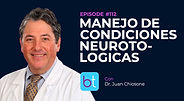BackTable / ENT / Podcast / Episode #100
Tympanic Membrane Perforation in Children
with Dr. Daniel Choo and Dr. Walter Kutz
In this episode of BackTable ENT, Dr. Gopi Shah, Dr. Walter Kutz (UT Southwestern), and Dr. Daniel Choo (Cincinnati Children’s Hospital) discuss indications and repair techniques for tympanic membrane perforation in children.
This podcast is supported by:
Be part of the conversation. Put your sponsored messaging on this episode. Learn how.

BackTable, LLC (Producer). (2023, March 30). Ep. 100 – Tympanic Membrane Perforation in Children [Audio podcast]. Retrieved from https://www.backtable.com
Stay Up To Date
Follow:
Subscribe:
Sign Up:
Podcast Contributors
Synopsis
First, the doctors discuss the typical patient presentation of a child with a perforated tympanic membrane (TM). Tympanostomy tubes falling out are the most common causes of this condition. Trauma and suppurative otitis media can also cause a TM perforation. The doctors emphasize the importance of taking a thorough history and asking about previous tubes, craniofacial abnormalities, the function of the contralateral ear, and recent trauma. Then, they discuss physical exam techniques to inspect the affected ear. All agree that using a standard otoscope is most useful in clinic, as the endoscope is more useful in the OR. Additionally, Dr. Choo notes that he usually streams the inspection on video monitors on the wall for kids and families to see.
Not all children with TM perforations have to undergo tympanoplasty. If there is a small perforation without hearing loss, watchful waiting may be appropriate. However, Dr. Kutz adds that if there is evidence of cholesteatoma or severe hearing loss, repair may be the best option after explaining all options to the parents. The doctors then weigh the risks and benefits of immediate TM repair versus watchful waiting and assess whether size and location of perforation matter. They conclude that the functional status of the children, evident through school performance and language development, have an important contribution when choosing a treatment option as well.
Next, the doctors discuss different tympanoplasty techniques, including different types of grafts (cartilage, fat, synthetic, etc.), ways to shape the grafts, and taking a microscopic versus endoscopic approach to the repair surgery. They also discuss common causes of failure and postoperative complications. Finally, they each explain their postoperative regimens and alternative rehab options if hearing does not improve enough after surgery.
Resources
Cook Medical
https://www.cookmedical.com/otolaryngology/
Transcript Preview
[Dr. Walter Kutz] My overall big three criteria to fix a perforation would be if there is evidence of a cholesteatoma, if they have chronic otorrhea that they're on multiple sets of ototopical drops, and maybe sometimes they get a lot of oral antibiotics from their pediatrician, and then if they have really significant hearing loss. Those are the kids I would typically address, but a kid with a cleft palate, other syndromic issues, higher risk of eustachian dysfunction, oftentimes I'll try to follow them as long as I can, and a lot of times, even if it's some hearing loss, they can wear a hearing aid pretty successfully.
The Materials available on BackTable are for informational and educational purposes only and are not a substitute for the professional judgment of a healthcare professional in diagnosing and treating patients. The opinions expressed by participants of the BackTable Podcast belong solely to the participants, and do not necessarily reflect the views of BackTable.














